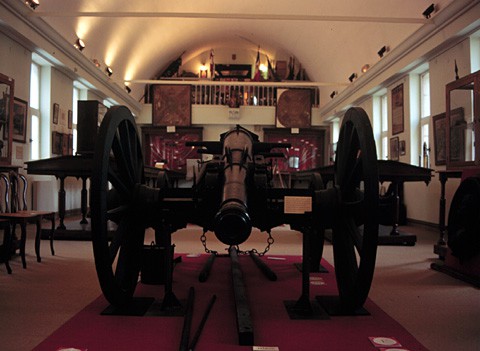
The history of the Canonniers Sédentaires de Lille is closely linked to that of the city. In 1235, the city was emancipated and had to take on the heavy costs of building and fortifying the city. Of the archers, crossbowmen, the swordsmen and gunners who could be mobilised by the aldermen, all that remained were the Canonniers Sédentaires, to be reorganised first in 1483 and later in 1803 by the first consul Bonaparte. The Battalion of the Canonniers Sédentaires is today the only survival in France of the militias of the Medieval communes.
The museum collection is held in a convent which belonged to the Soeurs Clarisses, known as the Soeurs Urbanistes d’Oudenaerde. This building dates from the 18th century and has a monumental entrance portal in the style of a triumphal arch but with the columns replaced by canon barrels. An inscription on the entablature reads ‘Napoleon 1st Emperor to the Canoniers of Lille’ and this is accompanied by a list of all the sieges in which the battalion played a part.
The Napoleonic theme makes a reappearance immediately in the entrance hall where there are engravings recording the emperor’s actions in favour of the town and the Canonniers. For it was in July of 1803 that the First Consul made his first trip to Lille accompanied by Josephine. He inspected the fortifications and visited an exhibition of industrial and craft products put on show in the Old Stock Exchange. Bonaparte declared himself satisfied and undertook measures in Lille’s favour, notably: the transfer of the customs from Douai; the granting of permission to grow tobacco; and the creation of a secondary school. It was on this occasion that he decided to reorganise the Canonniers into a single battalion in return for their brilliant service during the siege of 1792 (decree of 13 Fructidor, An XI). A second decree, dated 2 Thermidor, An XII (21 July, 1804), granted them the convent which had belonged to the Soeurs Urbanistes. The emperor made a second visit to Lille in May 1810, this time accompanied by Marie-Louise, and the guard of honour for the couple was performed by two platoons from the Canonniers Sédentaires.
The entire history of the Canonnier batallion (120 men divided into two companies with the uniform of the artillery of the line, whose patron saint is Saint-Barbe) is shown on the two floors of the museum. Paintings, sculptures, engravings, maps, fighting and dress weapons, uniforms and documents of many different sorts give a picture of the batallion’s history beginning in the 15th century and going right up to the Second World War. The jewels in the collection are two 1765 4-pounder Gribaeuval cannons given by Bonaparte during the reorganisation of An XI. The two cannons bear the inscription ‘The First Consul to the Cannoniers de Lille. 29 September, 1792’ and they are displayed with all their equipment, notably: cleaning brush, ramrod, limber, water bucket, control levers, pivot, dividers, quick-matches, leather fingerstalls, etc. Only three examples in the world of these cannons have survived, the third being in Paris at the Hôtel des Invalides army museum.
The walls of the rooms are decorated with engravings and busts. There is a remarkable bronze bust of Napoleon by Corbet. The work was carved from life in Egypt when Napoleon was commander in chief of the Armée d’Orient. Other cases put on show objects from different moments from the 19th century (Empire, the July Monarchy, the Restoration, The Second Republic, the Second Empire and the Third Republic) and some of the important campaigns (Crimea, Mexico and The War of 1870). On the back wall of one of the rooms there is a cenotaph designed by the architect Benvignat which holds the mortal remains of general François de Négrier (1788-1848). The general was mortally wounded during the repression of 1848 when leading a company of Canonniers over the great Saint-Antoine barricade.
